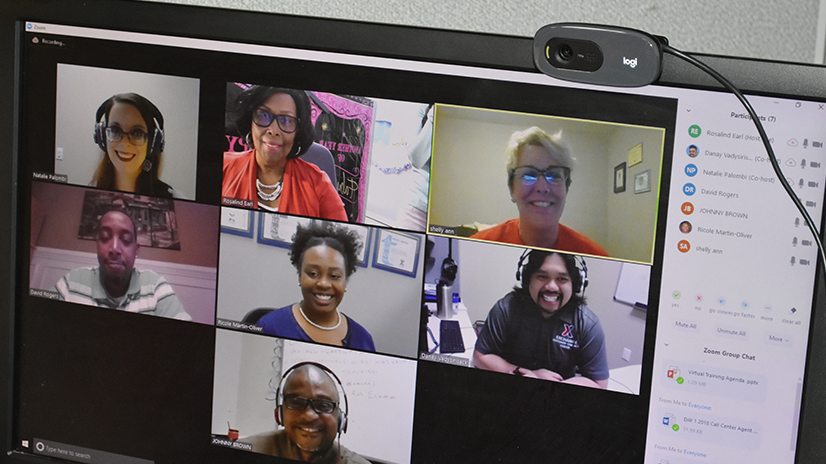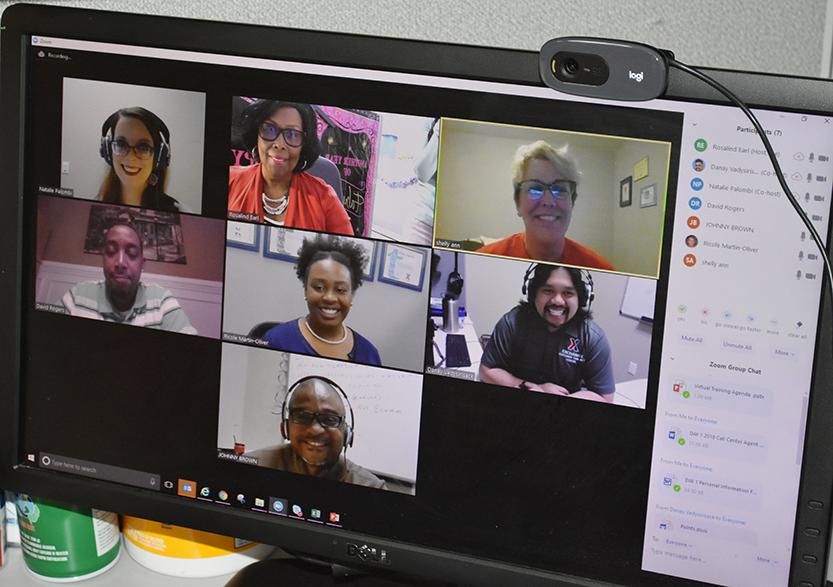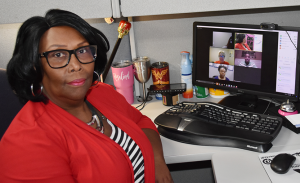Thinking Outside the Classroom: Contact Center Training Goes Virtual


Led by Manager Natalie Palombi, top left corner, Contact Center associates working remotely around the world receive virtual training.
When the Exchange Contact Center wanted to pilot a program for remote agents around the country, managers knew they’d need a new way to deliver training for the 30 systems and 650 processes that agents need to know to take calls from customers.
The Contact Center training team—Natalie Palombi, Rosalind Earl, Willie Nanez, Jeanette Moss and Doug Brodess, under Johnny Brown and with Curriculum Designer Danay Vadysirisack—used the challenge as an opportunity to rethink and reimagine how they approached training.
As a result, the new training program that rolled out last fall became entirely virtual for both remote agents and headquarters agents.
More efficient
“With the virtual training, you can go at your own pace,” said Wynne Gardner, who has worked as a Contact Center agent for two years. “You can stop it, pause it, rewind it. And it’s consistent. You know that you’re learning the same thing that everybody else is learning.”
The training is also more efficient for agents:
- Subject-specific modules range from 5 to 30 minutes.
- Modules are easier to digest and allow agents to refresh their knowledge on specific topics at any time.
- Instead of pulling agents off the phone and putting them in a classroom for hours, managers can assign training for associates to complete when call volumes allow.
- If new training is needed—for a specific promotion, for example—training can be created and assigned to agents much faster than previously creating training and scheduling classroom time for agents.
Better quality assurance
In the past, Contact Center managers would randomly select calls to listen to and grade agents based on their interaction with customers.

Rosalind Earl, customer service and quality assurance training specialist, guides associates from around the world through the Exchange’s virtual training program.
“We were recording all our calls, but weren’t really leveraging that as a resource,” said Director of Credit Operations Charlotte Stadler.
Managers now use software that transcribes every call and automatically analyzes the conversation using keywords. If the analysis shows that an agent is struggling on a particular issue—price matching, for example—a manager can assign the price-matching training module.
More helpful resources for agents
“It’s a learning tool, not a teaching tool,” Earl said of the new training. “There’s more responsibility on the agents to take charge of their training, and they’ve stepped up.”
There are more resources at the agents’ fingertips, too, such as:
- Searchable, web-based reference guide. The thousands-of-pages-long document used to be a PDF that required an exact match for searches. The reference guide is now broken down into subject-specific articles that can be easily searched.
- Agents can take real calls much earlier in the training process with a manager on the call who can instant message the agent to guide them.
“The training program is amazing. It’s very user-friendly,” said Megan Perez, one of the Exchange’s first remote agents who works from her home at Fort Campbell, Ky., where her husband is assigned. “We can look things up quicker and, in turn, we’re helping our customers quicker and more efficiently.

